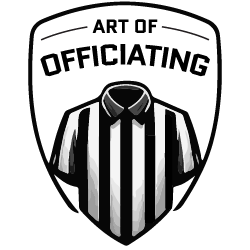In the previous Ready for Play article, we discussed using descriptive words to provide clarity when communicating with coaches.
In this article, we’ll look at words officials sometimes use that don’t really say anything. They’re either jargon, misleading, or just empty, and they offer little value in communication.
I also want to highlight a few words that, while found in the Rules Book, could lead to confusion or agitation.
Held or Interfered (without amplifying words) – As we discussed in the previous article, these words should not be used alone (without descriptive verbs). It’s not correct to only say, “Coach, A55 held his opponent; that’s why you see my flag on the ground” or “Coach, your player interfered with the receiver’s ability to catch the pass.” In both cases, we missed the descriptive words that help justify the flag. What exactly happened that made this go from “nothing” to a foul?
Cheap shot, Drilled him, Blew him up – These words are emotionally charged and vague. Avoid using jargon that is not found in the Rules Book. If we toss a flag for illegal personal contact, we need to clearly state the illegal action in Rules Book terms. “Coach, the receiver was attempting to catch a pass. Your player did not attempt to make a play on the ball, initiate contact with open hands, or attempt a wrap-up tackle. By rule, that is a foul.”
Targeting – While the word “targeting” is in the NFHS Rules Book (2-20-2, 9-4-3m) and is a foul, we should avoid using this word in front of coaches and players. The consequences of a targeting foul are different in the NFHS and NCAA codes. In NFHS, targeting does not automatically result in disqualification. Coaches watch college games on TV and associate the term “targeting” with ejection. Using “targeting” on a high school field can create unnecessary turmoil. It is appropriate for the crew to stand away from the coaches and players to discuss a targeting foul and possible consequences.
Kick – I understand this is semantics, but I want to reinforce the need to use precise Rules Book words in our conversations with coaches. Rule 2-24-1 says a kick is an intentional act. Rule 9-7-1 says no player shall intentionally kick the ball other than as a free or scrimmage kick. A player trying to recover a loose ball following a fumble will sometimes unintentionally strike the ball with his foot, and the opposing coach will demand we throw a flag for illegal kicking. When I explain why the action was not a foul, I will purposefully not use the word “kick” in my statement. “Coach, by rule, kicking is an intentional act. In my judgment, the player did not intentionally strike the ball with his foot, so it is not a foul.
Our conversations should be clear, concise, and correct. Use precise, descriptive language from the Rules Book. Avoid jargon, words that could be misconstrued, or vague terms that don’t add clarity.
Quiz
Read the quiz stem and then choose the best answer. (Choose all that apply.)
3/15 from the K-35. At the snap, R12 tackles gunner K8 at the K-35. The covering official throws a flag for holding. R40 fields the kick at the R-30 and returns the ball to midfield.
- Enforce the penalty from the K-35 (previous spot)
- Enforce the penalty from the R-30 (end of the kick)
- Enforce the penalty from midfield (end of the run)
- The game clock will start on the snap
- The game clock will start on the ready for play
- 25 second play clock
- 40 second play clock
Review Rules 2-16-2h, 3-4-2, 3-4-3, 3-6-1, 10-4-2b
